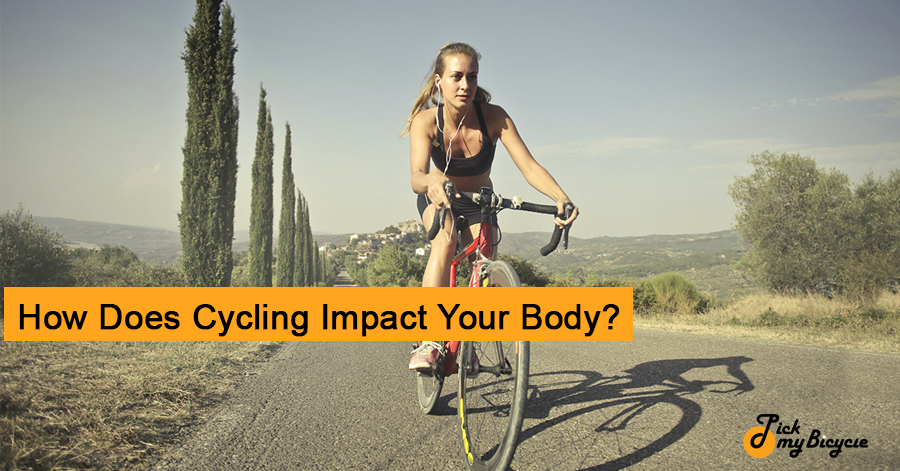How Does Cycling Impact Your Body?
Cycling is an activity for the entire body and mind. Thus, the numerous advantages of riding are self-evident. Cycling may be known as the perfect adaptable and low-impact workout alternative, with benefits ranging from improved mental wellness and a lean physique to good cardiovascular health. Do you realize how beneficial riding is to your body only when you get on a cycle and peddle to move it? Cycling does not only target the lower body, contrary to common assumptions. Cycling influences all your muscles, including those that appear unconnected to riding at first. In this article, we will know how cycling may help you improve your body form. We go into the results of cycling on the entire body in depth. It's vital to note that cycling's effects differ from person to person. And notably from man to woman. As a result, the impact of cycling on the body begins with the sort of physique you have. Let's look at how cycling impacts your body form, why muscles all over the body get affected, and how it affects a person's mental and cardiovascular health.
1. Cycling can assist you in losing weight:
Cycling regularly, particularly at a high effort, can aid in decreasing body fat and boosting appropriate weight management. Other research suggests that combining speed and muscle training with regular cycling might temporarily enhance your metabolism and develop muscle, allowing you to expend more calories even when you're not exercising.
2. Muscle development in the lower body:
A bike provides several advantages for your physical and mental strength. You can test cycling's promise by going on a bike and riding up a hill or performing numerous resistance training. The burning feeling will begin in the lowest region of your body. This type of strength training increases hip, gluteal, and hamstring strength and function and improves total muscle constancy. Because of the precise configuration of the muscles, this results in a highly toned figure.
3. Develop your arms:
We must hold the grips straight, yet keeping balance requires strength for the cycle to work properly. It contributes to the tone and strength of our arms and muscles. As we bike farther, it takes a better form and looks nicer. Men tend to focus their attention on the hands over all other parts of the body. It is a significant difference from before, when we didn't exercise, to after we began cycling.
4. Reduced illness risk:
Numerous studies have found that frequent cycling, like other physical exercise, is related to a lower risk of various diseases and disorders. A 2017 research, for example, discovered that cycling to work gets connected with a decreased risk of cancer, cardiovascular disease, and early mortality. A study revealed that leisure and commuting cycling were consistently related to a lower incidence of type 2 diabetes.
5. Boost Testosterone:
Many analysis studies show that intensive or extended resistance exercise may suppress testosterone levels in males. When this is a contentious issue, other experts believe it is more nuanced, with other factors at play. According to research, professional cyclists have lower testosterone levels than non-athletes. The researchers thought that a combination of strength training and other variables, like high cortisol levels and perineum pressure, may have contributed to this reduction. There are two items to consider. For starters, they cycle vigorously for extended lengths of time, although this is less necessary for trainee or weekend cyclists. Second, testosterone grades flew as soon as the rider assumed a vacation. Strength exercises get revealed in research to improve testosterone levels in the short and long term.
6. Encourages healthy joints:
Low-impact workouts like spinning and cycling can increase joint mobility and lower the incidence of bone problems. In actuality, cycling is a recommended activity for joint and injury recovery. It is known to aid in the complete range of motion recovery after knee, ankle, and hip injuries. Cycling could be a good exercise for you if you have joint strain concerns or if you now have bone issues. Compared to other aerobic exercises like running or jumping sports, pedaling is less likely to put stress on the joints since it puts less force on them. Furthermore, cycling might lessen the discomfort you now have from arthritis.
7.Gluteus maximus:
While the triceps are the most significant muscle in cycling, the glutes and hamstrings are also crucial. The gluteal muscles in the buttocks and the hamstrings get stimulated while you pedal. These muscles function effectively, that is, in unison, to spread the hips and knees with each pedal stroke. According to thorough research, they can boost the glutes and hamstrings throughout the pedaling.
8. Fat-burning enzyme:
Cycling is a terrific way to burn calories, which can assist you in creating a calorie insufficiency for fat reduction. Cycling burns how many calories? It is known for numerous parameters such as intensity, resistance, speed, duration, and body weight. A 200-pound person cycling at a sensible velocity may burn around 350 calories in a 30-minute workout.
9. Brainpower:
Exercise get demonstrated objectively and consistently to be associated with brain health and to lessen cognitive alterations that may increase an individual's susceptibility to dementia in later life. Cycling has an impact on more than simply the physical body. You must have more mental capacity to enable your body to work twice as hard to get healthy. Cycling improves blood circulation by stimulating the brain, which contributes to a robust and healthy body.
Conclusion:
Cycling has advantages for the heart, muscles, and mind, including improved heart health, increased perception, and less stress. Daily riding does come with hazards, such as overuse injuries. Moreover, a doctor's advice or that of a trained fitness professional should get obtained before beginning any new fitness regimen. Cycling impacts three main body parts: the back, upper body, and lower body. The muscles in the thighs and calves make up the lower body. The arms and shoulders are part of the upper body. The middle region of the body includes the back and abdomen.

